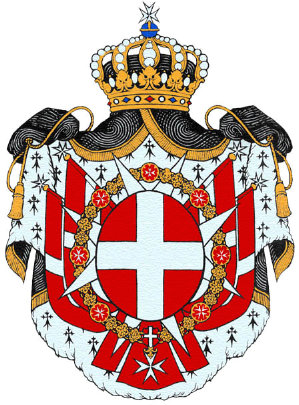World
About Andrew Cusack
 Writer, web designer, etc.; born in New York; educated in Argentina, Scotland, and South Africa; now based in London.
Writer, web designer, etc.; born in New York; educated in Argentina, Scotland, and South Africa; now based in London. read more
News
Blogs
Reviews & Periodicals
Arts & Design
World
France
Mitteleuropa
Knickerbockers
Argentina
The Levant
Africa
Cape of Good Hope
Netherlands
Scandinavia
Québec
India
Muscovy
Germany
Academica
Philipp Freiherr von Boeselager, 1917-2008
Catholic Nobleman, Forester, Knight of Malta, Plotted to Kill Hitler
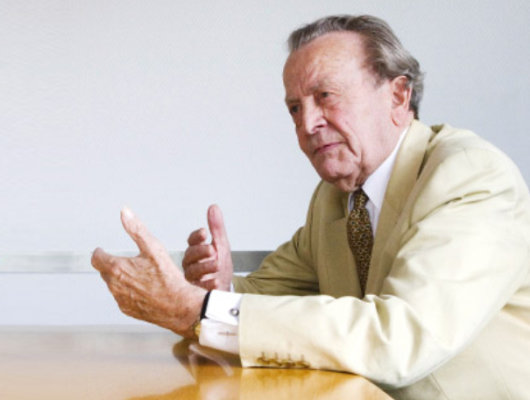
Philipp Freiherr (Baron) von Boeselager, the last surviving member of the conspiracy of anti-Nazi German officers, has died at 90 years of age. The freiherr‘s background and upbringing were distinctly Catholic. The Boeselagers are a Rhenish family with Saxon origins in Magdeburg. Philipp was the fourth of eight children and was educated by the Jesuits at Bad Godesborg. His grandfather had been officially censured by the Imperial German goverment for publically taking part in a Catholic religious procession.
Boeselager had most intimately been involved in the March 1943 plot to assasinate Hitler and Himmler when the the Fuhrer and the SS head were visiting Field Marshal Günther von Kluge on the Eastern Front. Boeselager, then a 25-year-old cavalry lieutenant under the Field Marshal’s command, was to shoot both Hitler and Himmler in the officers mess with a Walther PP. Himmler, however, neglected to accompany Hitler and so the Field Marshal ordered Boeselager to abort the attempt fearing that Himmler would take over in the event of Hitler’s death, changing nothing.
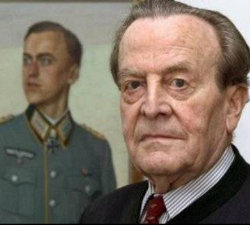 «Each day Hitler ruled, thousands died unnecessarily — soldiers, because of his stupid leadership decisions. And later, I learned of concentration camps, where Jews, Poles, Russians — human beings — were being killed.»
«Each day Hitler ruled, thousands died unnecessarily — soldiers, because of his stupid leadership decisions. And later, I learned of concentration camps, where Jews, Poles, Russians — human beings — were being killed.»
«It was clear that these orders came from the top: I realised I lived in a criminal state. It was horrible. We wanted to end the war and free the concentration camps.»
Boeselager later procured the explosives for the famous July 1944 plot (the subject of the upcoming film “Valkyrie“), under the cover of being part of an explosives research team. He handed a suitcase with the explosives on to another conspirator. When the bomb exploded in Hitler’s conference room, Boeselager and his 1,000-man cavalry unit made an astonishing 120-mile retreat in under 36 hours to reach an airfield in western Russia from where the aristocrat would fly to Berlin to join the other conspirators.
At the airfield, however, he received a message from his brother (Georg von Boeselager, a fellow cavalry officer who was repeatedly awarded for his consistent bravery on the battlefield) saying “All back into the old holes”, the code signifying the failure of the coup. Even more astonishingly than his swift retreat was his return, with his unit, to the front quickly enough not to raise any eyebrows. As a result, he was not known to be part of the conspiracy and escaped the gruesome tortures and executions dealt to many of his fellow conspirators.
After the war, his role in the plot was revealed and Philipp von Boeselager was awarded the Legion d’honneur by France and the Great Cross of Merit by West Germany. He joined the Order of Malta in 1946, eventually co-founding Malteser Hilfdienst, the medical operation of the German knights of the Order, and helping coordinate German pilgrimages to Lourdes.
The greater part of his post-war years was spent in forestry, and Boeselager served as head of the Arbeitsgemeinschaft Deutscher Waldbesitzerverbände (the coordinating body of private and cooperative forest-owners) from 1968 to 1988. Coincidentally, he was succeeded in that post by Franz Ludwig Schenk Count von Stauffenberg, the son of the July ’44 plot mastermind.
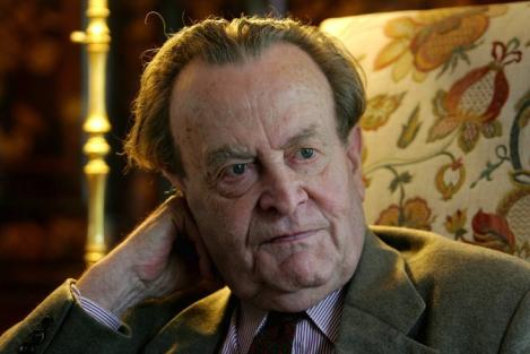
“Brideshead” Regurgitated

Well, the trailer for the film adaptation of Evelyn Waugh’s classic novel “Brideshead Revisited” is out, and the film is slated for a summer release here in the States. (Trailer | Official Site). Waugh fans can but lament that, whereas Waugh said the book was essentially about “the operation of divine grace”, the screenwriter of this adaptation openly admitted that the script “turns God into a villain”.
Rather than being bold and creating a genuine work of cinematic art to match the novel, they’ve decided to take the easy and conformist route and do a God-hating rompy flick. (Because we can’t have too many of those!). A shame, of course, but entirely predictable. Shall we at least have a look at the cast?
New Yorker Elected Mayor of London

Congratulations to that most-honoured son of the Empire State, Mr. Alexander Boris de Pfeffel Johnson MP, more commonly known as Boris, on his election to the mayoralty of Greater London. Mr. Johnson was born on these sacred shores some forty-four years ago on a pleasant June day. Boris has politics in the blood as his father Stanley is a former Conservative MEP, but let us hope he does not take after his great-grandfather, Ali Kemal Bey, who made enough unfortunate decisions during his brief tenure as interior minister of the Ottoman Empire that he was knicked from the barber shop of the rather-smart Tokatlian Hotel in Constantinople and lynched shortly thereafter.
Strangely enough, this is not exactly the closest connection New York and London have ever had. Sir Gilbert Heathcote, 1st Baronet was Lord Mayor of London in 1710 while his brother Caleb Heathcote was Mayor of the City of New York, exhibiting how interconnected our transatlantic British world was in those days. Caleb Heathcote was also Lord of the Manor of Scarsdale, which is just five minutes north of here on the train. Created in 1703, Scarsdale was the last manor granted in the entire British Empire. There were about a dozen manorial lordships here in New York, bringing the proud heritage of feudalism to the New World. The Manor of Gardiner’s Island survives to this day as the only manor in America in which the land is still entirely owned by the descendants.
The bulk of manorial privileges (incorporating the pre-existing patroonships from the olden Dutch days) were, alas, abolished in the 1840s, with the final holdouts taken care of in some legislation of 1911, but the Lord of the Manor of Pelham was presented with a fatted calf each St. John’s Day from the City Council of New Rochelle (honoring the Huguenots’ agreement purchasing the land from the Pells) well into the twentieth century.
The Heathcote name survives, in Derbyshire I believe, but not in America. Caleb Heathcote married the daughter of Col. William Smith, Chief Justice of the Province of New York, but had only daughters.
Slot Zeist
A country house in the Province of Utrecht

Utrecht is the smallest of Dutch provinces, being little more than a remnant of the once-powerful Prince-Bishopric of Utrecht. The city of Utrecht is the province’s capital and namesake, not to mention the primatial see of all the Netherlands. Just outside the provincial capital is the town of Zeist with its splendid little ‘palace’, Slot Zeist. The house was built from 1677 to 1686 on the ruins of Kasteel Zeist, the castle of the von Zeist family which died out in the fourteenth century (or survived through the Borre van Amerongen family, depending on how you look at it).
Cry God for Britain, Harry, and St. Aidan?
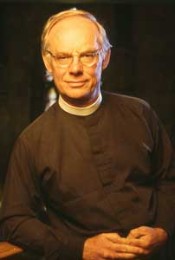
“St Aidan unites three of the countries by having lived there,” Dr. Bradley says, “and is, I believe, a better symbol for Britishness” [than the George, Andrew, and Patrick, the patrons of England, Scotland, and Ireland respectively].
“It’s like Billy Bragg says in his song ‘Take Down the Union Jack’ about Britain; ‘It’s not a proper country, it doesn’t have a patron saint’. Aidan was the sort of hybrid Briton that sums up the overlapping spiritual identities of Britain.
“He also makes a good patron saint of Britain because of his character. He was particularly humble and believed in talking directly to people. When he was given a horse by King Oswald of Northumbria, he immediately gave it away because he was worried that he would not be able to communicate properly.
“He was also not shy of reprimanding the mighty and powerful about their failings. He saw it as part of his job to remind secular rulers not to get above themselves. At a time when we are thinking about what makes Britishness, he had a sense of openness and diversity for his time that I think makes him a good candidate as the patron saint of Britain.”
Find out more in this article:
“Home-grown holy man” (The Independent, 23 April 2008)
On a somewhat similar note, here’s Aelianus (one of our favourite bloggers) writing on British Identity last September.
And you thought subsidising the poor was bad…
Millions of tax dollars taken from hard-working Americans are going to subsidise one of the wealthiest school districts in the country
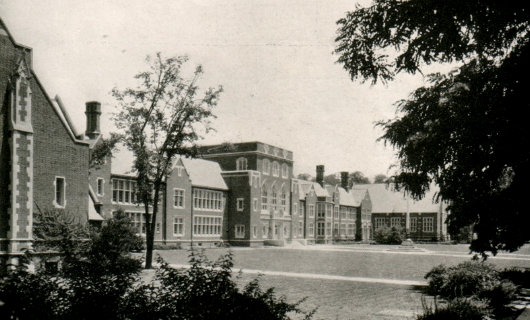
The Bronxville School (as it is called, since all grades from kindergarten to 12th are in the same building) ostensibly has a number of things going for it. It has a rather splendid collegiate gothic building in an excellent setting in one of the handsomest villages in all of the Empire State. Its school district is a mere square-mile, meaning most students can walk to school and it doesn’t even have a bus system. It has a private foundation funded independently by parents and alumni to support the school. What more could a public school possibly need?
Well, according to the geniuses down in Washington, D.C., $5.4 million in federal grants. The school, you see, is built on a site which frequently floods. Our main street in Bronxville is called Pondfield Road for a reason: the field with the pond is the open space where the school now stands. It’s been flooding for decades and so floods should come as no surprise. The nor’easter that blew through town a year ago flooded the school severely, closing it for over a week. The flooding was particularly bad during the last nor’easter because the school had spent a great deal of money (privately-raised, not from the public purse) to replace its natural football field with a lower-maintenance fake turf alternative. They did this instead of saving the money for, oh, say, one of those floods that happens every so often.
The money has been secured from the Federal Emergency Management Agency by our congresswoman, Nita Lowey (D). “When a natural disaster occurs, the federal government has a responsibility to help communities recover,” said Lowey, who neglected to provide any legal or moral backing for such an untruthful and baseless claim.
The school district of one of the wealthiest communities in the country is filching off the hard-working people of America in order to clean up the mess that is a direct result of its own poor spending decisions and inability to plan properly. Is there no shame?
Our Lady of Esperanza
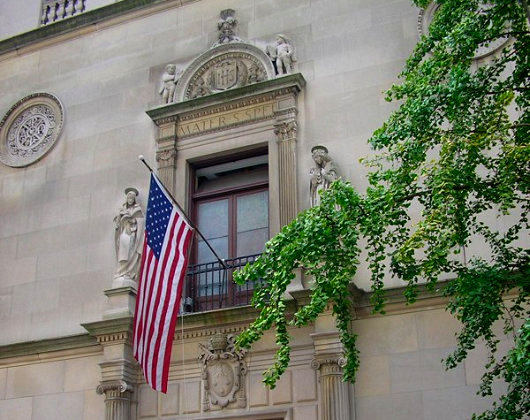
The Church of Our Lady of Esperanza, 156th Street & Broadway. The Church was built by Archer Huntington at the urging of Doña Manuela de Laverrerie de Barril and designed by Huntington’s brother Charles. The sanctuary lamp was a gift from King Alfonso XIII of Spain. The present façade dates from 1924, when the Church was expanded under the direction of Lawrence G. White, the son of Stanford White of McKim Mead & White and himself a partner in his father’s firm.
The right direction
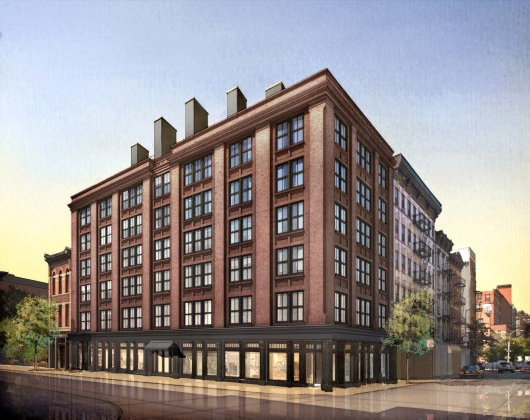
What’s this? A building built from the ground up by a developer in New York, and designed to look like a New York building? Something to look forward to at 211 Elizabeth Street.
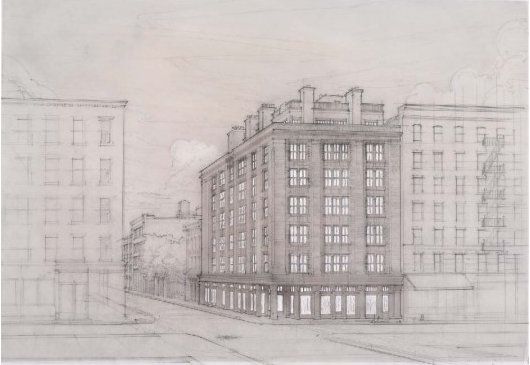
(more…)
“Valkyrie”

No, this isn’t a photograph of the latest Norumbega staff meeting, it’s a publicity shot from the upcoming United Artists film, “Valkyrie”. The film tells the story of Claus Philipp Maria Schenck von Stauffenberg, the heroic German Catholic noble who was the mastermind behind the July 20 plot against Hitler. Needless to say, there has been much anticipation over this film, especially since the lead role went to Tom Cruise, who has never quite got the knack of acting. Like Jeremy Irons, he seems to believe that completely different characters require little or no change in performance, but is mysteriously still making films nonetheless. (Cruise at least has the excuse of being a Scientologist to explain his success… what’s Jeremy Irons’s?).

Despite the poor choice of Mr. Cruise play Count Stauffenberg, the rest of the cast includes some pretty inspired choices. Playing Countess Nina von Stauffenberg is Carice von Houten (above), whom you will remember from “Zwartboek”. She’s joined by fellow “Zwartboek” actor Christian Berkel (top photo, seated far left), who played the evil General Kaütner in the Dutch film, the character responsible for the downfall of the good German, General Müntze, who was played by Sebastian Koch (better known for his role in the hit “Das Leben der Anderen”) who (pause for breath) actually played Count Stauffenberg himself in a 2004 German television production called “Stauffenberg”. Speaking of downfalls, Berkel (we’re back to him now) also played a nasty Nazi in the 2004 film “Downfall” depicting the last few days in Hitler’s bunker. [Correction: Berkel actually played Dr. Ernst-Günter Schenck, one of the good guys.] Some more of the cast…
(more…)
The Late Great Bank of New York

Doesn’t it often seem that as soon as something you actually like comes along, it’s only a short amount of time before it’s gone again? This is how I feel about the latest, and indeed last, logo and general visual identity of the Bank of New York. Readers are no doubt aware that the Bank of New York is the oldest bank in America (founded by Alexander Hamilton) and that its was the first share traded on the New York Stock Exchange when that great financial market was founded beneath a buttonwood tree in 1792.
In 2005, the Bank of New York finally dumped their 1980’s-feel, dated-but-traditional logo in favor of a new design put together by the New York brand house of Lippincott (then still known as Lippincott Mercer). The logo suggested an old stock or bank note but its polychromatic scheme gave it a modern vibrancy. The adjacent logotype was along similar lines: “Bank” and “New York” in a tasteful, restrained modern with “The” and “of” in a delightfully traditional fluid colonial script.

But on July 1, 2007, the ancient Bank of New York merged with a foreign interloper, the Mellon Financial Corporation of Pennsylvania and the disgusting hybrid child of the marriage is cumbersomely monikered: “The Bank of New York Mellon”. How awkward and ungainly! Along with the merger came a new logo, also designed by Lippincott, which you can see on the BNYM website. This pitiful modern arrowhead design says little, other than one might suffer bodily harm at its handling.
The 2005 Bank of New York logo evoked a sense of solidity. “I have deep roots and firm foundations,” it seemed to say, “but am nonetheless modern and adapting to change”. Think of the feel, the smell, of a worn bank note and then compare it to the dull, prickly arrowhead which threatens injury. The old logo you stick in you pocket and gain a sense of security from. The new logo you worry a ninja might hurl at you.
It was an error even to change the name, if you ask me. “The Bank of New York” has such a simplicity and a solidity to it, which the new name rather lacks. It is just like the old New York law firm of Dewey Ballantine, which suffered a takeover recently and is now known as “Dewey and LeBoeuf”. Rather sounds like a pair of huckster Louisiana lawyers hoping to make a few off the innocent inhabitants of the Bayou. So stick to the tried and the true, folks. It usually works.
Spring hath duly sprung
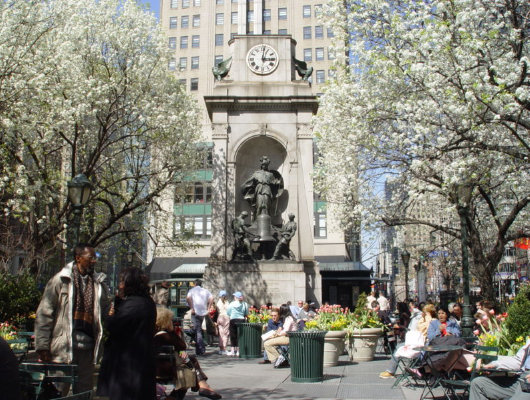
Herald Square, at the confluence of Broadway and the Avenue of the Americas.
A Miracle from Blessed Charles
Vatican to Review Case of Inexplicable Healing of Florida Woman
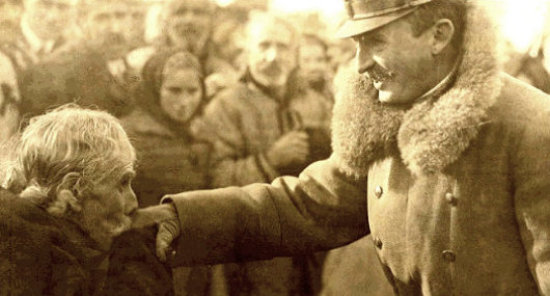
The seemingly inexplicable healing of a Baptist woman from Florida may provide the miracle necessary for the canonization of Emperor Charles of Austria. The woman, in her mid-50s, suffered from breast cancer and was bedridden after the cancer had spread to her liver and bones. Despite treatment and hospitalization, doctors diagnosed her case as terminal. But after intercessory prayers to the Emperor Charles, the woman (who wishes to maintain her privacy and remain unnamed) was completely healed.
The story begins when Joseph and Paula Melançon, a married couple from Baton Rouge, Louisiana and friends of the healed woman, travelled to Austria, where they met Archduke Karl Peter, son of Archduke Rudolf, and grandson of the holy Emperor Charles. The Archduke invited the couple to his grandfather’s beatification in Rome in 2004. Mrs. Melançon gave the novena to Blessed Charles to her sister-in-law, Vanessa Lynn O’Neill of Atlanta.
“I knew that when I got that novena — I knew that my mother’s best friend was sick — I just knew at that moment that it was something I was going to do,” Mrs. O’Neill told the Florida Catholic in an interview. “And that is how I got started, I just prayed the novena.”
The woman’s recovery was investigated by an official church tribunal consisting of Father Fernando Gil (judicial vicar of the Diocese of Orlando), Father Gregory Parkes (chancellor of canonical affairs of the Diocese), Father Larry Lossing, diocesan notary Delma Santiago, as well as an unnamed medical doctor. The tribunal examined the evidence at hand and invited the participation of medical experts, who could find no earthly explanation for the woman’s recovery.
“Other alleged miracles attributed to the intercession of Blessed Karl I are currently being investigated in different places in the world,” Fr. Gil said.
The sixteen-month investigation has now concluded, and the conclusions have been signed by the participants, sealed, and placed in special boxes which are then themselves tied, sealed with wax, and sent to the Congregation for the Causes of the Saints in Rome via diplomatic pouch. The Congregation will examine the case further and then present its findings to Pope Benedict XVI, who will decided if a miracle has taken place. If the Pope is convinced by the evidence, then the Emperor’s canonization can proceed.
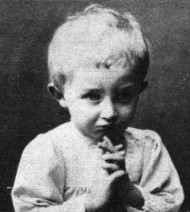 The future emperor, 1889 |
Blessed Charles’s reign as Emperor of Austria and Apostolic King of Hungary began in November 1916 during the First World War. The Emperor realized the heavy toll the Christian countries were suffering and almost immediately began to make peace manouevers. The insane obstinacy of both his German allies and the enemy alliance of France, Great Britain, and the United States, however, meant that Charles’s multiple attempts to negotiate a mutually-acceptable end to the war were not even considered.
After the war, President Woodrow Wilson insisted on dismantling the Austro-Hungarian Empire and the Emperor was forced into exile, first in Switzerland and finally, after two attempts to regain his Hungarian throne, on the Portuguese island of Madeira. Charles had always been particularly devout, and his devotion to God only increased when he caught a severe case of pneumonia on Madeira. He died from the illness in April 1922.
The English writer Herbert Vivian wrote that Charles was “a great leader, a prince of peace, who wanted to save the world from a year of war; a statesman with ideas to save his people from the complicated problems of his empire; a king who loved his people, a fearless man, a noble soul, distinguished, a saint from whose grave blessings come.”
Even Anatole France, the radical French intellectual and novelist, wrote “Emperor Karl is the only decent man to come out of the war in a leadership position, yet he was a saint and no one listened to him. He sincerely wanted peace, and therefore was despised by the whole world. It was a wonderful chance that was lost.”
Recent history has come to fulfil the expectations of Pope St. Pius X, who received Charles when the Austrian was a young archduke and not in direct line to succeed to the throne, saying “I bless Archduke Charles, who will be the future Emperor of Austria and will help lead his countries and peoples to great honor and many blessings–but this will not become obvious until after his death.”
Herbert Ritter von Karajan: 1908-1989
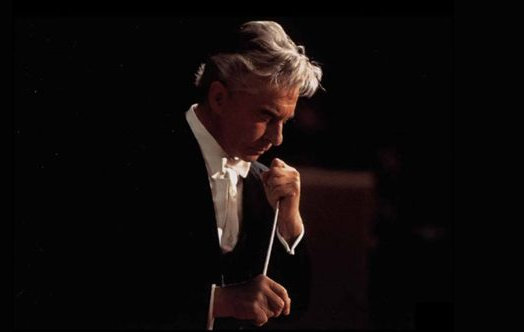
Saturday was the one-hundredth anniversary of the birth of the brilliant Herbert Ritter von Karajan of Salzburg, conductor of the Berliner Philharmoniker for thirty-five years. There is a famous (and probably apocryphal) anecdote of Karajan leaping into a taxicab and, when being asked as to his destination, replying “No matter. I am in demand everywhere.” He is of course very well known for his Wagner, but here we present the latter half of Beethoven’s Symphony No. 9: (more…)
Mourning in Vienna
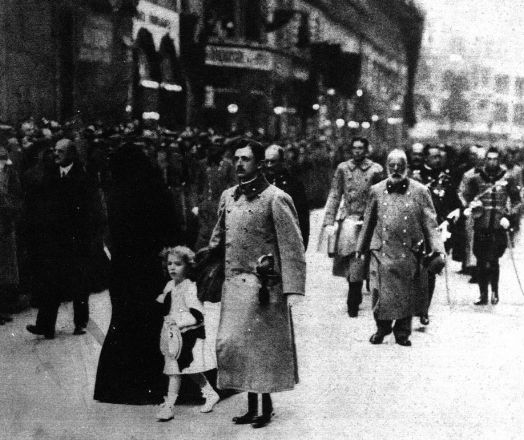
The Blessed Emperor Charles at the funeral of the late Emperor Franz Joseph, the saint’s great uncle, in November 1916. Between the Blessed Charles and his Empress, Zita of Bourbon-Parma, is Crown Prince Otto. Otto lives today, and is the head of the Hapsburg family.
Grant us the grace, with his intercession, to follow his example and serve the true cause of peace, which we find in the faithful fulfillment of Your holy will. We ask this through Jesus Christ our Lord, who lives and reigns with You and the Holy Spirit, one God, forever and ever.
Amen.
Category: Monarchy | Previously: Our Holy Emperor
In Old New York
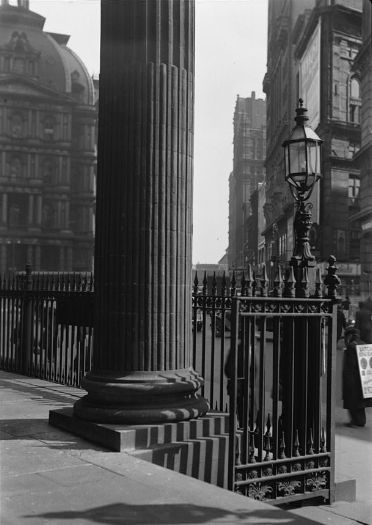
The steps of St. Paul’s Chapel, Broadway, looking towards Park Row, March 1937.
Will ye no’ come back again
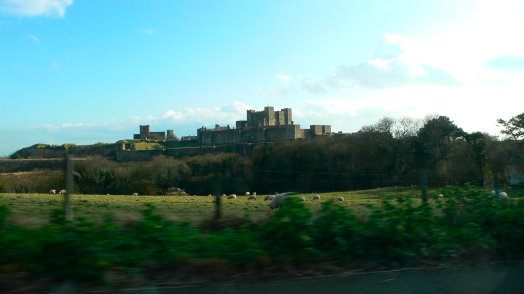
I am back already, which seems far too soon, and yet I had an immensely splendid time. It felt like more than just a week and I am sure that is due to the extraordinary generosity of my numerous hosts and friends in Scotland and England. I present to you two photographs I took during my recent trip: alas they are both in England, and indeed both in Kent, which is not terribly representative as I covered territory as far up as the choppy white waves of the North Sea and as far down as the White Cliffs of Dover. Above is an action shot of Dover Castle taken from the car, and below is the gatehouse to the cathedral close in Canterbury.
Why no Caledonian pix, you ask? I was simply too busy enjoying the place. Besides, it is a not-widely-known fact that photography does not actually function north of the Tweed. In a mandatory practice originating in a nineteenth-century labour dispute, all photographs smuggled out of Scotland are actually clever reproductions created by a secret guild of gremlins. This ensures both full employment amongst the gremlin population, and their complete separation from the ordinary human world (though a quick glance at the Scottish Labour party might cause one to doubt this is still enforced).
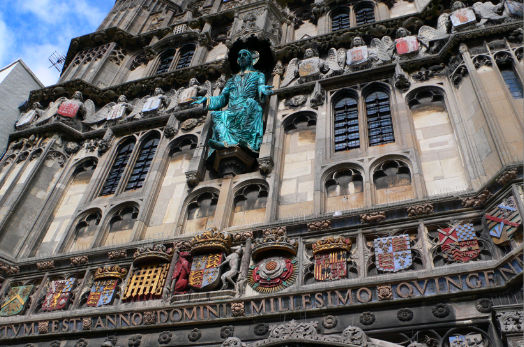
Upcoming Events
April 26, 2008 (Saturday)
The Birthday of Rome: 753 B.C. – 2003 A.D.
The Roman Forum Spring Ball
7:00pm – midnight
Catholic Center at New York University
238 Thompson Street
(between Washington Square South & West 3rd Street)
A, B, C, D, E, F, V trains to West 4th St.; R to 8th St.; 6 to Bleecker St.
7-Piece Rich Siegel Ballroom Orchestra
Grand Imperial Buffet and Dessert
Well Done Roma! Festivities and Spontaneous Outburst of Joy, 10:00 pm.
According to tradition, Romulus took up his trusty plow and marked out a sulcus around “Shepherds’ Hill” on the twelfth day before the Kalends of May, i.e., a.d. XII Kal. Mai-a date which, give or take eleven or twelve days, roughly corresponds to what we call April 21st. Conveniently, the date was also the festival of the shepherd goddess Pales (the Parilia), in whose honor the hill, chosen by Romulus, had been named the Palatine.
When the festival was adopted by city dwellers, the date was set to coincide with the date of the traditional founding of Rome. Each area of Rome set up festivities, much like a block party. Bonfires were set onto which offerings were thrown. The event concluded with a bountiful feast set up out of doors. Catholics can also commemorate the day due to Rome’s Christian meaning.
Two songs will be sung at the 10:00 P.M. festivities: The papal hymn, Roma Immortale, and Rome’s Birthday Song, the latter to the tune of Oklahoma, with lyrics by Judy Hallet.
For further information please contact the Roman Forum (dvhinstitute@aol.com or call 212-645-2971).
COST
$50 per person
(Children 16 and under, free)
Reserve by April 21
ATTIRE
Suit and tie or dinner jacket for the men
Checks payable to:
The Roman Forum
11 Carmine Street, 2C
New York, NY, 10014
May 3, 2008 (Saturday)
The Glass of Absinthe and the Rules of the Game
Part two of the Roman Forum’s Modern Image & Catholic Truth series
9:00am – 5:00pm
Catholic Center at New York University
238 Thompson Street
(between Washington Square South & West 3rd Street)
A, B, C, D, E, F, V trains to West 4th St.; R to 8th St.; 6 to Bleecker St.
Modern man has a positive image of himself that has been shaped and very effectively propagandized since the time of the Renaissance. The Roman Forum’s Modern Image and Catholic Truth series explores the gap between this image and the true predicament in which both the individual and contemporary society as a whole now find themselves imprisoned.
Part Two: The Glass of Absinthe and the Rules of the Game
This year’s series began in November with a conference called The Sleep of Reason, designed to underline the fact that modern naturalism ends with the destruction of the rational in man, achieved in a variety of different ways depending upon the particular approaches of the thinkers and activists concerned.
The Glass of Absinthe and The Rules of the Game were originally intended to be two separate conferences—the first focusing on the destructive aspects of the naturalist separation of the individual from society and his own past; the second on the intellectual, artistic, psychological and socio-political obstacles placed in the path of identification of the disease that afflicts us. These have now been combined into one session— the last Roman Forum event in the United States in the 2007-2008 academic year.
9:00 – 10:00 am
Registration and coffee hour
10:00 – 11:00 am
The Glass of Absinthe and the Rules of the Game
Dr. John C. Rao
St. John’s University, Director of Roman Forum
11:15 am – 12:15 pm
The Empire of Nothingness
Christopher A. Ferrara, Esq.
President, American Catholic Lawyers Association
12:15 – 1:45 pm
Luncheon
1:45 – 2:45 pm
Citycraft and Soulcraft
Dino Marcantonio, AIA
Architect and Lecturer at the Yale School of Architecture
3:00 – 4:00 pm
Reason Gone Mad
James Kalb, Esq.
International Catholic lecturer and writer; author of The Tyranny of Liberalism: Understanding and Overcoming Administered Freedom, Inquisitorial Tolerance, and Equality by Command (Fall, 2008, ISI Books).
4:00 – 5:00 pm
General Discussion
For further information please contact the Roman Forum (dvhinstitute@aol.com or call 212-645-2971).
COST
$35: Reserve by April 28, entrance & luncheon
$10: Pay at the door, entrance alone
Checks payable to:
The Roman Forum
11 Carmine Street, 2C
New York, NY, 10014
Fra’ Matthew Festing
Northumbrian, Art Expert, Veteran of the Grenadier Guards is Seventy-Ninth Prince & Grand Master of the Order of Malta
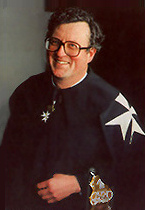 FRA’ MATTHEW FESTING, the Grand Prior of England, was today elected Prince and Grand Master of the Order of Malta. The new grand master was chosen in a secret ballot by the Complete Council of State. After receiving the approval of the Pope, His Most Eminent Highness swore the Oath before the council and the Cardinal Patronus of the Order, Cardinal Pio Laghi. Fifty-eight years old, Fra’ Matthew was, up to this point, an art expert for the auction house Sotheby’s. The Prince is the son of Field Marshal Sir Francis Festing who, as Chief of the Imperial General Staff, was the effective head of the British Army. Sir Francis converted to Catholicism and married a member of the Riddells of Swinburne Castle, a prominent recusant family. Through his mother, Fra’ Matthew is descended from the Blessed Sir Adrian Fortescue, an English Knight of Malta who was martyred for the Faith in 1539. The grand master’s brother Andrew Festing, RP is a noted portraitist.
FRA’ MATTHEW FESTING, the Grand Prior of England, was today elected Prince and Grand Master of the Order of Malta. The new grand master was chosen in a secret ballot by the Complete Council of State. After receiving the approval of the Pope, His Most Eminent Highness swore the Oath before the council and the Cardinal Patronus of the Order, Cardinal Pio Laghi. Fifty-eight years old, Fra’ Matthew was, up to this point, an art expert for the auction house Sotheby’s. The Prince is the son of Field Marshal Sir Francis Festing who, as Chief of the Imperial General Staff, was the effective head of the British Army. Sir Francis converted to Catholicism and married a member of the Riddells of Swinburne Castle, a prominent recusant family. Through his mother, Fra’ Matthew is descended from the Blessed Sir Adrian Fortescue, an English Knight of Malta who was martyred for the Faith in 1539. The grand master’s brother Andrew Festing, RP is a noted portraitist.
As a child, Fra’ Matthew lived in Egypt and Singapore where his father held army postings, and was educated at Ampleforth Abbey in Yorkshire and St. John’s College, Cambridge. Passing out from Sandhurst, he was commissioned an officer in the Grenadier Guards, Britain’s most senior infantry regiment. (The Coldstream Guards are actually older, but their seniority was reduced for backing Cromwell in the Civil War). Currently holding the rank of Colonel in the Territorial Army, Fra’ Matthew served the Queen as Deputy Lieutenant for Northumberland for many years, and was appointed OBE.
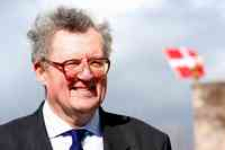 “The new Grand Master affirms his resolve to continue the great work carried out by his predecessor,” an official statement from the Order of Malta said, noting Fra’ Matthew’s “wide range of experience in Order affairs”. Having joined the Order of Malta in 1977, Fra’ Matthew took solemn vows in 1991 and was appointed Grand Prior of England in 1993, when the Grand Priory was resurrected after 450 years in abeyance. In that post he led humanitarian missions to Kosovo, central Serbia, and Croatia, and has attended the annual British pilgrimage to Lourdes with the handicapped and the disabled. “As well as his passion for the decorative arts,” the official announcement continued, “and for history, for which his encyclopaedic knowledge of the history of the Order is legendary, as is his very British sense of humour, Fra’ Matthew spends any free time possible in his beloved Northumberland countryside.”
“The new Grand Master affirms his resolve to continue the great work carried out by his predecessor,” an official statement from the Order of Malta said, noting Fra’ Matthew’s “wide range of experience in Order affairs”. Having joined the Order of Malta in 1977, Fra’ Matthew took solemn vows in 1991 and was appointed Grand Prior of England in 1993, when the Grand Priory was resurrected after 450 years in abeyance. In that post he led humanitarian missions to Kosovo, central Serbia, and Croatia, and has attended the annual British pilgrimage to Lourdes with the handicapped and the disabled. “As well as his passion for the decorative arts,” the official announcement continued, “and for history, for which his encyclopaedic knowledge of the history of the Order is legendary, as is his very British sense of humour, Fra’ Matthew spends any free time possible in his beloved Northumberland countryside.”
This election is a most welcome one, and I would go so far as to say the councillors have chosen very wisely. It is an immense honour for we English-speaking Catholics that yet another Grand Master has been chosen from our ranks. But of course Fra’ Matthew was not chosen for being an Anglophone but rather for being Matthew Festing. Like Pope Benedict, he is a friend of the old rite of the Mass, and he was among the many prominent British Catholics (whose number included James MacMillan, Michael Ancram, Damian Thompson, Jamie Bogle, and others) who signed the ‘Appeal from the British Isles’ to Pope Benedict imploring a liberalization of the restrictions on the Tridentine rite (duly granted by the Holy Father in his motu proprio Summorum Pontificum of July 2007).
While certainly an ardent respecter of tradition, Fra’ Matthew is by no means a stuffy man but rather, as the Order’s official statement noted, is known for his sense of humour. On the only occasion on which I met Fra’ Matthew, I introduced him to Mrs. Burke (then Fraulein Hesser). Upon discovering that Abby hailed from the great state of California, Fra’ Matthew regaled us with his memories of driving from Denver all the way to the Pacific coast of California. Upon reaching the great ocean (the Grand Prior very enthusiastically informed us), he took off his shoes, rolled up his trousers and went straight in!
The Order of Malta has been remarkable in that it has had no qualms about modernization while at the same time unabashedly keeping to its ancient traditions. In this, it is a shining beacon in a world which too often and too easily disregards the time-tested ways of our ancestors. The very prompt election of Fra’ Matthew shows that the Order is of a firm mind and on a sound footing. We have no doubt that Fra’ Matthew will continue the great centuries-long tradition of the Order of Malta: to defend the Faith, to serve the Poor.
to
FRATER
Matthew Festing
Prince and Grand Master
of the Sovereign Military and Hospitaller Order of St. John
of Jerusalem of Rhodes and of Malta
Most Humble Guardian of the Poor of Jesus Christ
Category: Order of Malta
A Lawyer’s Studio in Recoleta

This property in the Recoleta neighborhood of Buenos Aires was once a residential apartment until a multi-generational family of lawyers bought and transformed it into a law office. (more…)
Search
Instagram: @andcusack
Click here for my Instagram photos.Most Recent Posts
- Amsterdam November 26, 2024
- Silver Jubilee November 21, 2024
- Articles of Note: 11 November 2024 November 11, 2024
- Why do you read? November 5, 2024
- India November 4, 2024
Most Recent Comments
- on The Catholic Apostolic Church, Edinburgh
- on Articles of Note: 11 November 2024
- on Articles of Note: 11 November 2024
- on Why do you read?
- on Why do you read?
- on University Nicknames in South Africa
- on The Situation at St Andrews
- on An Aldermanian Skyscraper
- on Equality
- on Rough Notes of Kinderhook
Book Wishlist
Monthly Archives
Categories


